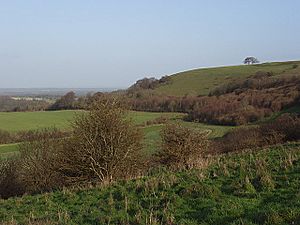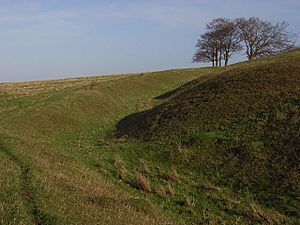Ladle Hill facts for kids
| Site of Special Scientific Interest | |

Looking northeast towards Ladle Hill
|
|
| Area of Search | Hampshire |
|---|---|
| Interest | Biological |
| Area | 10.5 hectares (26 acres) |
| Notification | 1984 |
| Location map | Magic Map |
| Ladle Hill | |
|---|---|
| Highest point | |
| Elevation | 232 m (761 ft) |
| Geography | |
| Location | Hampshire, England |
| Topo map | OS Landranger 174 |
| Climbing | |
| Easiest route | Wayfarer's Walk |
Ladle Hill is a special place in Hampshire, England. It's known for its amazing nature and old history. This hill is a Site of Special Scientific Interest, which means it's protected because of its important plants and animals. It's also a Scheduled monument, meaning old structures here are kept safe.
Contents
Archaeology: Discovering the Past
On top of Ladle Hill, there's an ancient hillfort. This fort was built during the Iron Age, a time long ago. It's shaped like a rectangle and covers about seven acres. The fort has strong banks and ditches around it.
Archaeologists have never dug up this hillfort. But its banks and ditches are very clear and well-kept. It looks like the builders started work in different sections. For some reason, they stopped before it was finished.
There are also old burial mounds, called barrows, nearby. One large disc barrow is just north of the fort. Many other barrows used to be in the area, but farming has flattened them over time.
The Unfinished Hillfort Mystery
Ladle Hill is one of the most famous unfinished hillforts in Britain. An archaeologist named Stuart Piggott first studied it in 1931. He realized it was never completed.
This unfinished fort helps experts understand how Iron Age people built these huge structures. Because it's not finished, we can see things that would normally be hidden. For example, there are marks where they planned out the fort. There are also piles of chalky soil left from digging the ditches. This soil was meant to be used for the ramparts (the fort's walls).
Scientists used special tools to scan the ground in 1997. They found no signs of an old settlement inside the fort. This suggests that people never actually lived there. It seems the fort was abandoned before anyone moved in.
The fort was meant to cover about 3.5 hectares (8.6 acres). It was marked by a small ditch or an earlier fence. Besides the piles of building material, there isn't much else inside the fort.
What's Around Ladle Hill?
The area around Ladle Hill has other interesting old features. There's a long ditch that runs for about 2,000 meters (2,187 yards). It ends near a group of burial mounds called Seven Barrows. This ditch also marks the edge of an old field system.
Another long ditch is to the east of the hillfort. It's about 700 meters (766 yards) long. There's also another large field system in this area. You can see it from the air as marks on the ground.
To the southwest, there are two square-shaped enclosures. Each is about 0.3 hectares (0.74 acres) in size. We don't know exactly when they were built. But they might be linked to grazing areas from the late Bronze Age to early Iron Age.
Just north of Ladle Hill, there's a well-preserved disc barrow. It's about 170 feet (52 meters) wide. There are also signs of platforms that might have been an old settlement. But this area hasn't been fully explored yet.
Inside the northern part of the fort, there's a small, low mound. It's about 3 meters (10 feet) wide. People thought it was another disc barrow. But scans didn't find a ditch around it. The mound is hard to see now, but old photos show it was clearer in the past.
Roman History
On the steep western side of the hill, there's a Roman earthwork. It's a large bank built into the slope. It might have been a small circus (a type of arena) or even a pond.
Geology: The Hill's Foundation
Ladle Hill is made of Cretaceous Upper Chalk. This chalk forms shallow, well-drained soils on the slopes and tops of the hill. These chalk landscapes often look very dramatic. They have rolling hills and steep slopes called escarpments. Escarpments form where chalk layers have been pushed up or broken.
You can see marks on many chalk hills in England from centuries of sheep grazing. The slopes look stepped or striped. This happens from soil slowly moving down the hill and from sheep paths. These marks are very clear on Ladle Hill.
Ecology: Home to Rare Plants
The plants and animals on Ladle Hill are very important. That's why it was named a biological Site of Special Scientific Interest in 1978. Ladle Hill is a great example of a calcareous grassland chalk downland habitat. These habitats are now rare in Britain.
The hill is home to some unusual and rare plant species. The old earthwork areas are especially rich in different kinds of plants. You can find many downland grasses there. There are also large groups of rare plants like:
- field fleawort (Senecio integrifolius)
- chalk milkwort (Polygala calcarea)
- hairy rock-cress (Arabis hirsuta)
- fragrant orchid (Gymnadenia conopsea)
- pyramidal orchid (Anacamptis pyramidalis)
The slopes of the earthwork also have many species. Some, like the clustered bellflower (Campanula glomerata), only grow there.
The hill is also important for a rare type of burnt-tip orchid (Orchis ustulata). This orchid flowers in July and looks different from other types. It's now found in only a few places in Britain.
Other plants on the hill include salad burnet, thyme, fairy flax, and hairy violet. There are some scattered bushes on the north side, but they aren't taking over the grassland.
Location: Finding Ladle Hill
Ladle Hill is located on Great Litchfield Down. It's southeast of the village of Old Burghclere in Hampshire. The very top of the hill is 232 meters (761 feet) above sea level. It sits within the area of Litchfield and Woodcott. Parts of the hill also fall into the areas of Burghclere and Ecchinswell, Sydmonton and Bishops Green.
Nearby to the west is Beacon Hill. To the east is Watership Down, a famous place from a book. Also to the northeast is Old Burghclere Lime Quarry SSSI. The A34 road runs between Ladle Hill and Beacon Hill.
You can easily visit Ladle Hill and the surrounding downs. There are public footpaths, including the long-distance Wayfarer's Walk, which passes nearby.
Images for kids






